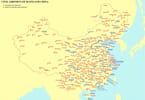A scary day for India, Indian security and perhaps travel to India. After North Korea has been shaken up the world with ballistic missile tests after Hawaii got woken up on Saturday with a false ballistic missile inbound alarm, India is now proudly announcing it had fired its Agni-V intercontinental ballistic missile (ICBM) in its final operational configuration from the Abdul Kalam Island off the Odisha coast, taking another step forward toward its eventual induction into the Strategic Forces Command (SFC).
Indian media is saying the nuclear rocket can reach northernmost parts of China. There had been tensions between China and India. Did India mean North Korea? No matter what, the world just became an even more dangerous planet. Luckily India has a stable democracy in place at this time, but this high-tech country with a billion people may be another time bomb for the world in progress.
The only difference today, the United States and the rest of the world are not saying much – nuclear weapons and developments like this seem to become business as usual. Luckily the test wasn’t launched from Iran, Syria or North Korea- this could have started World War 3 today.
The Agni-V was last tested on December 26, 2016, which was then described as the fourth and final experimental test of the three-stage missile. The tri-Service SFC, established in 2003 to manage India’s nuclear arsenal, will have to conduct a few more user-trials before the 50-tonne missile is produced in adequate numbers for induction.
While the 17-meter long Agni-V was tested in an “open configuration” in April 2012 and September 2013, the third and fourth tests in January 2015 and December 2016 saw it being fired from a hermetically sealed canister mounted on a Tatra launcher truck.
MIT KELL ELVENI A CIKKBŐL:
- After North Korea has been shaken up the world with ballistic missile tests after Hawaii got woken up on Saturday with a false ballistic missile inbound alarm, India is now proudly announcing it had fired its Agni-V intercontinental ballistic missile (ICBM) in its final operational configuration from the Abdul Kalam Island off the Odisha coast, taking another step forward toward its eventual induction into the Strategic Forces Command (SFC).
- The tri-Service SFC, established in 2003 to manage India’s nuclear arsenal, will have to conduct a few more user-trials before the 50-tonne missile is produced in adequate numbers for induction.
- In April 2012 and September 2013, the third and fourth tests in January 2015 and December 2016 saw it being fired from a hermetically sealed canister mounted on a Tatra launcher truck.





















